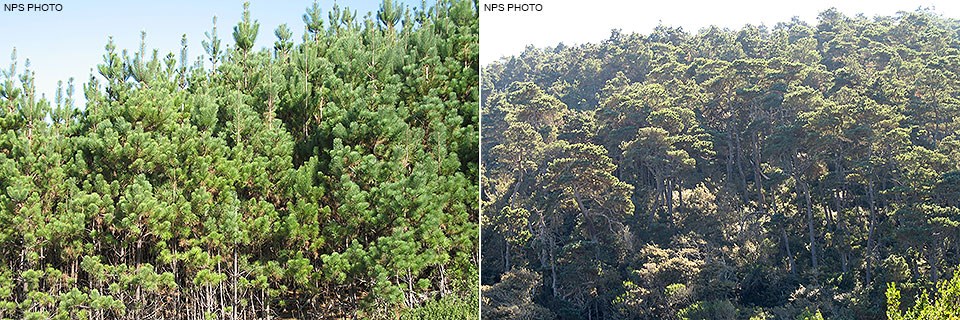|
Bishop pine (Pinus muricata) forests are found primarily on the northern section of Inverness Ridge (see Vegetation Map) on granitic quartz-diorite soils. The Point Reyes population is part of a larger population with limited distribution. The species is found in relict stands along the coast of California from Humboldt to Santa Barbara counties, on Santa Cruz and Santa Rosa islands, and in isolated populations south to central Baja. The distribution of bishop pine is maritime and populations are found between sea level and about 400 m elevation. The climate in this coastal band is dominated by summer fog which is probably an important moisture source during the dry summer months. According to the 1994 vegetation map for the Seashore, there were 3,570 acres of bishop pine forest prior to the Vision Fire. Approximately 35% of this total forest area was burned in the 1995 Vision Fire. Bishop pine is the dominant tree species in this community. Madrone (Arbutus menziesii), tanoak (Lithocarpus densiflorus), coast live oak (Quercus agrifolia) and California bay (Umbellularia californica) are often present in significant cover. Huckleberry (Vaccinium ovatum) is important to dominant in the shrub layer. Other species common in the understory include salal (Gaultheria shallon) and swordfern (Polystichum munitum). The areas burned in 1995 are characterized by a patchwork of extremely dense stands of 12 to 15 foot tall, regenerating pines alternating with extremely dense stands of blue blossom (Ceanothus thrysiflorus) and Marin manzanita (Arctostaphylos virgata). Bishop pine is a fire dependent, serotinous pine species. Cones are produced each year, but remain closed. Typically, cones are opened by fire, but they can also occasionally be opened on a hot day. The fire regime in bishop pine forests is generally a stand replacement regime. bishop pine is not considered to be fire resistant. Mature trees are killed by even low intensity fires and seeds are dispersed onto the newly burned ground where they germinate. Bishop pine stands are normally even aged and for the first 10–20 years after fire are extremely dense. Cone production was observed as early as five years after the Vision Fire. In 2003, a researcher found seedling densities as high as 71 seedlings/m² with an average value of 25 seedlings/m² in the year immediately after the after the Vision Fire. 
Much of the bishop pine forest in the Seashore currently is (as of 2020) about 25 years old, having established after the 1995 Vision Fire. Older stands were sampled and were found to have established after the 1927 fire and after fires set by Ottinger during the 1950s. Bishop pines in Tomales Bay State Park were found to be as old as 71 years. Trees not exposed to fire a period in excess of 80 years will likely begin to succumb to diseases such as western gall rust and die without reproducing. The non-native pathogen pine pitch canker was recently discovered in the bishop pine forest at Point Reyes. The effects this disease will have on the population are unknown, but they are likely to be significant. The disease seems to be spreading more rapidly in the areas of bishop pine forest that have come back since the Vision Fire. These fast-growing young trees may be especially susceptible. A 2009 study at San Francisco State University mapped areas affected by pine pitch canker. (1,353 KB PDF) More information on the Bishop Pine Forest Plant Community. Text adapted from the Point Reyes National Seashore's Draft Wildland Fire Resource Advisor Guide (2,436 KB PDF).
|
Last updated: February 5, 2024
